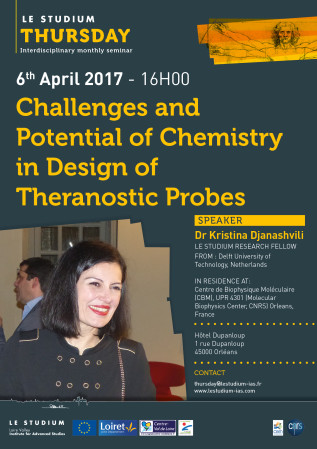Dr Kristina Djanashvili

From
Delft University of Technology - NL
In residence at
Center for Molecular Biophysics (CBM) / CNRS - FR
Host scientist
PROJECT
Responsive Nanozeolites: Smart Porosity And Surface Tailoring For Multimodal Imaging And Therapy Of Cancer
Effective cancer treatment requires its early diagnosis and safe drug delivery systems. Up to date many therapeutics have failed due to their limited ability to reach the diseased site selectively without damaging healthy cells. Furthermore, none of the existing imaging techniques is absolutely reliable due to the differences in resolution and sensitivity. Therefore, synergistic combination of imaging modalities in one probe is the key strategy to benefit, for example, from the sensitive and quantifiable PET signal and the high resolution of MRI. Nanozeolites are among the most promising candidates for realization of this concept due to their unique crystalline structure capable of stable loading with metal-ions with diagnostic and therapeutic properties. Even though, these materials have found many applications in various technologies, their medicinal use has not been fully explored yet.
This research is aiming at exploitation of smart hierarchical nanozeolites with modified framework. The mesoporous fragments in the framework will be used for encapsulation of drug molecules (e.g. doxorubicin), while small cavities will be irreversibly loaded with paramagnetic metal-ions (MRI) and PET-tracers. The in vivo efficacy of the designed materials will rely on over-expression of specific molecules (sialic acid) and enzymes (proteases) in tumors compared to healthy regions. Specific surface modification with conjugated phenylboronic moieties and the bulky poly-L-glutamic acid will render nanozeolites with responsive properties: the ability to recognize over-expressed sialic acid in tumors followed by enzymatic cleavage of sugar residues by proteases and release of the drug. Moreover, enzymatic hydrolysis of the coating will open up the pores giving water molecules access to the zeolite interior and hence increase relaxivity as well as trigger the local release of the drug.
Publications
Self-aggregating calix[4]arenes carrying four DOTA ligands on the upper rim for stable complexation of paramagnetic Gd III-ions have already been proposed as MRI probes. In this work, we investigate the luminescence properties of Tb III-DOTA-calix[4]arene-4OPr containing four propyl-groups and compare them with those of the analog substituted with a phthalimide chromophore (Tb III-DOTA-calix[4]arene-3OPr-OPhth). We show that, given its four aromatic rings, the calix[4]arene core acts as an effective sensitizer of Tb-centered luminescence. Substituents on the lower rim can modulate the aggregation behavior, which in turn determines the luminescence properties of the compounds. In solid state, the quantum yield of the phthalimide derivative is almost three times as high as that of the propyl-functionalized analog demonstrating a beneficial role of the chromophore on Tb-luminescence. In solution, however, the effect of the phthalimide group vanishes, which we attribute to the large distance between the chromophore and the lanthanide, situated on the opposite rims of the calix[4]arene. Both quantum yields and luminescence lifetimes show clear concentration dependence in solution, related to the strong impact of aggregation on the luminescence behavior. We also evidence the variability in the values of the critical micelle concentration depending on the experimental technique. Such luminescent calix[4]arene platforms accommodating stable lanthanide complexes can be considered valuable building blocks for the design of dual MR/optical imaging probes.
Surface PEGylation of nanoparticles designed for biomedical applications is a common and straightforward way to stabilize the materials for in vivo administration and to increase their circulation time. This strategy becomes less trivial when MRI active porous nanomaterials are concerned as their function relies on water/proton-exchange between the pores and bulk water. Here we present a comprehensive study on the effects of PEGylation on the relaxometric properties of nanozeolite LTL (dimensions of 20 × 40 nm) ion-exchanged with paramagnetic GdIII ions. We evidence that as long as the surface grafting density of the PEG chains does not exceed the “mushroom” regime (conjugation of up to 6.2 wt % of PEG), Gd-LTL retains a remarkable longitudinal relaxivity (38 s–1 mM–1 at 7 T and 25 °C) as well as the pH-dependence of the longitudinal and transverse relaxation times. At higher PEG content, the more compact PEG layer (brush regime) limits proton/water diffusion and exchange between the interior of LTL and the bulk, with detrimental consequences on relaxivity. Furthermore, PEGylation of Gd-LTL dramatically decreases the leakage of toxic GdIII ions in biological media and in the presence of competing anions, which together with minimal cytotoxicity renders these materials promising probes for MRI applications.
Final reports
Effective cancer treatment requires its early diagnosis in combination with safe drug delivery mechanisms. Up to date many therapeutics have failed due to their limited ability to reach the diseased site selectively without damaging healthy cells. Furthermore, none of the existing imaging techniques is absolutely reliable due to the differences in resolution and sensitivity. Therefore, synergistic combination of imaging modalities in one, typically nanodimensional, probe is the key-strategy to benefit from, for example the sensitive and quantifiable PET signal and the high resolution of MRI. Nanozeolites are among the most promising candidates for realization of this concept due to their unique crystalline structure capable of stable hosting of metal-ions with diagnostic and therapeutic properties. Even though, these materials have found many applications in various technologies, their medicinal potential still requires thorough investigations. This project aimed at the design, preparation and testing of novel nanozeolitic probes that can be applied as personalized drugs for diagnostic and therapeutic purposes


